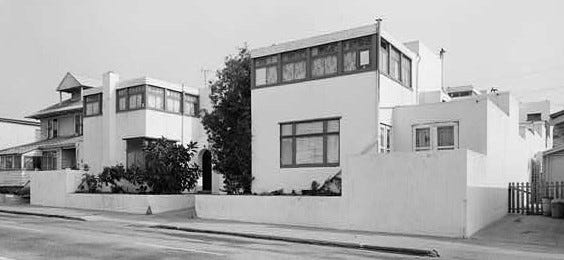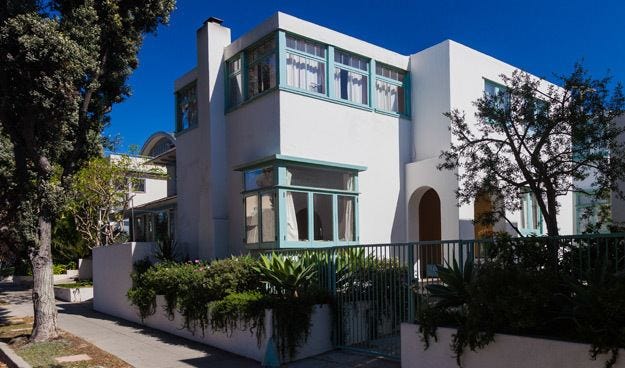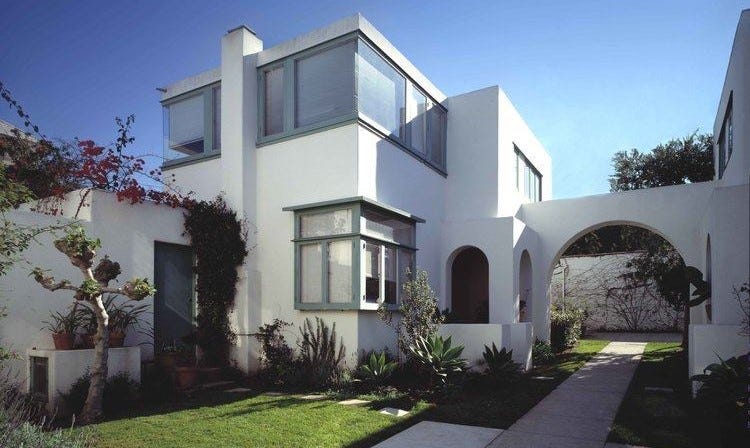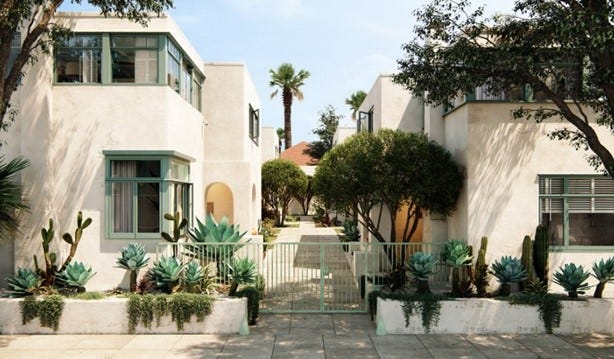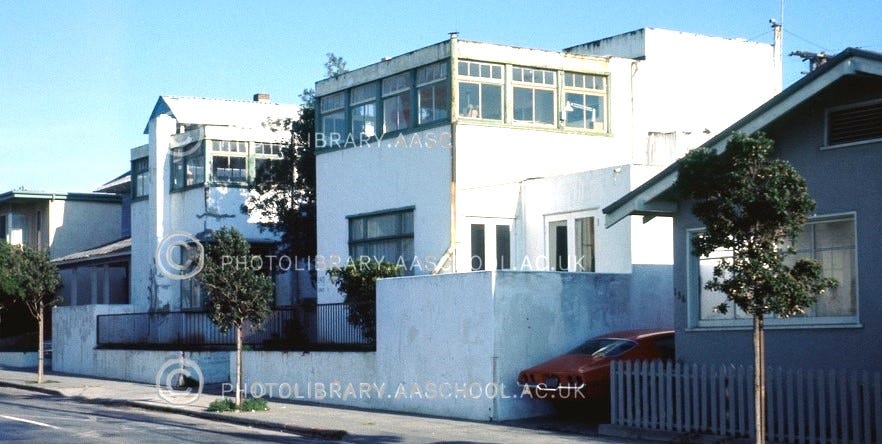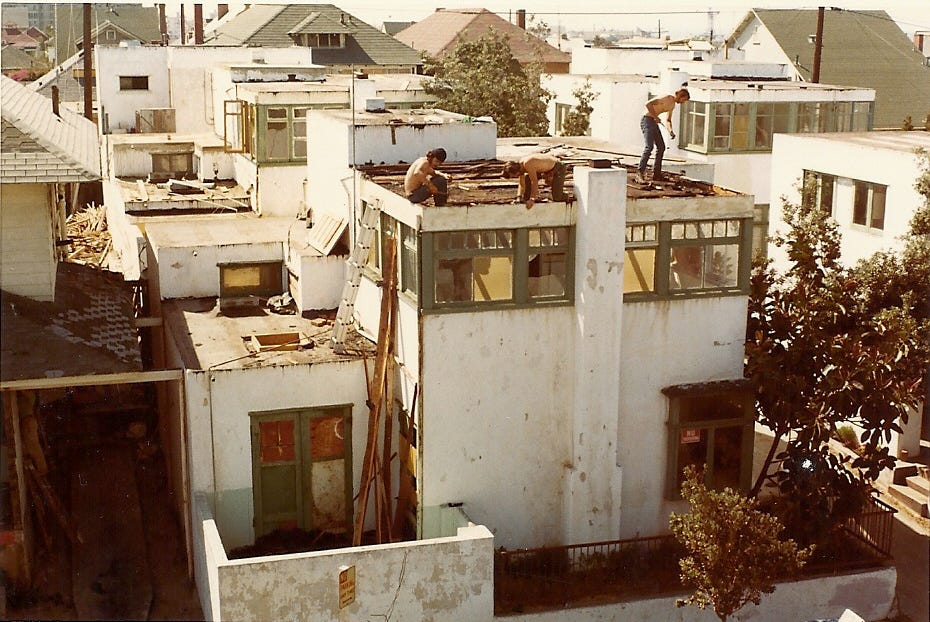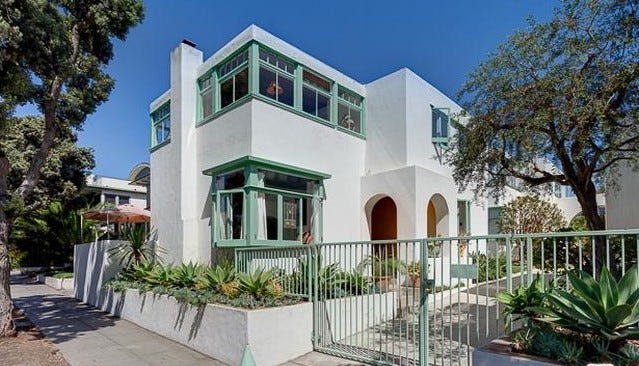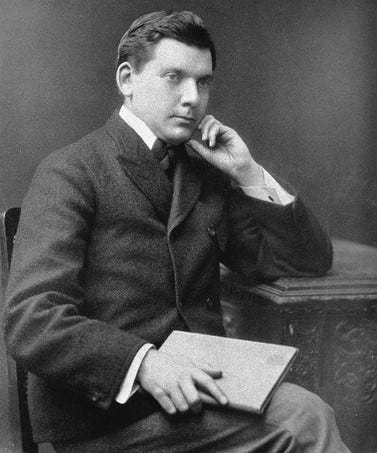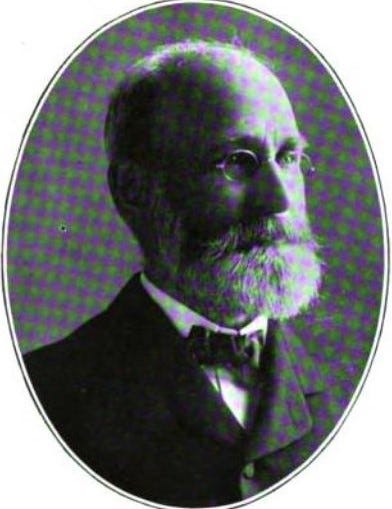Unit #2 of the 100-year-old Horatio West Court has become available for the first time in three decades with an asking price of $2.15 MM. Ownership of the unit includes a 1/4-shared interest in two rental units at the rear of the property and the property’s Mills Act tax benefits
The 4-unit, 2-story Horatio West Court was designed by architect Irving J. Gill1 for Horatio D. West.2 West a founder, with his brother, of the St Paul, MN legal publisher West Publishing Company,3 had retired to Altadena, CA in 1900. When he commissioned Gill in 1919, West listed his address as 143 Wadsworth Ave - the 1905 2-story house which is directly behind (i.e. south of) 140 Hollister.
Horatio West Court remains the sole evidence of San Diego-based Gill’s achievement in Los Angeles. Although built in 1919 - 1922 as upper-middle-class winter-vacation housing, it is typical of Gill's social housing for low-income groups in its compactness; the off-street environment created; and the use of concrete as a material.
In the early decades of the 1900s, Gill completed many high-profile commissions, but after 1920 produced little work and his profile quickly faded. In 1936, Gill died in relative obscurity in north San Diego County4, and for decades, Gill’s work went unappreciated, neglected, and in many instances, demolished.
By the 1960s, Horatio West Court was in a state of alteration and disrepair. Fortunately, a group of Gill enthusiasts restored the complex during the 1970s.
In 1977, Horatio West Court became the first building in Santa Monica to be listed on the National Register of Historic Places, and in 1979 was designated a City of Santa Monica Historic Landmark.
Gill’s reputation has also been restored and he is now recognized as a seminal figure in 20th century modernist architecture.
Irving John Gill (1870 – 1936)
Born in 1870 in upstate New York, with no formal architectural education, the teenage Gill began his career as a draftsman for a local architect, before moving to Chicago to work with Joseph Silsbee. In 1893, Gill went to work for Adler and Sullivan, where he trained with chief draftsman Frank Lloyd Wright and absorbed the architectural tenets of what would later become known as the Chicago School.
After falling ill, Gill left Chicago in 1893 for San Diego; eventually recovering his health and opening his own practice. When California passed a law in 1901 requiring architects to obtain a license, Gill was automatically granted a license because his practice was already in operation. When Gill landed in San Diego in 1893, Southern California architecture, like the rest of the country, was still eminently Victorian - with every surface an excuse for some kind of elaboration. Gill spent most of his career in southern California where, in the early 1900s, he developed an original and radical simplification of Mission style architecture. His work radically redefined the architectural landscape of Southern California and set the stage for a later, more widely celebrated generation of modernists (Richard J. Neutra, R.M. Schindler, and their followers), who would continue his experiments with new forms and construction techniques.
Magical as they appear now, Gill’s designs failed to find a wide audience in his lifetime. He was slated to become the chief architect for San Diego’s 1915 Panama-California Exposition, but insider lobbying replaced him with Bertram Goodhue. Goodhue’s ornate Spanish Colonial Revival Style architecture swept California in place of Gill’s simple shapes.
After 1916, Gill gave up his San Diego practice. In 1919, Gill started living and working in Los Angeles. His Los Angeles projects include Lewis Court (1910) in Sierra Madre; the Dodge House (1916) in Hollywood (demolished in 1970); and Horatio West Court (1919) in Santa Monica.
After 1920, his work slowed considerably due to lingering illness, changing public tastes, and his diminishing desire to compromise with clients. A bachelor until the age of 58, Gill married Marion Waugh Brashears (1870 - 1952) in 1928 and moved to Carlsbad. In 1936, at the age of 66, Gill died in relative obscurity. For decades, Gill’s work went unappreciated, neglected, and in many instances demolished.
Gill's commitment to socially-responsible architecture, the use of rational planning and construction techniques, and his sympathetic response to climate and local building traditions, made his work attractive to the next generation of southern California architects.
Horatio David West (1848-1936)
Born in Massachusetts, his family moved to St Paul, MN in 1870. Horatio, who was working as a bookkeeper for a local hardware supply firm, married Elizabeth R. “Eliza” Barney West (1849 - 1917) in 1875.
In 1876, he joined his brother John West’s legal publishing business as a partner. The business quickly grew. When John West left the company abruptly in 1900, control of the business passed to Horatio. But within a few months, poor health required Horatio to give up management of the day-to-day operations of the company, and he retired to Altadena - although he remained president of the company until 1908.
West and his family (wife Eliza, sons Horatio Earl West (1876 – 1915) and Fred Carter West (1882 – 1913), and daughter Elsa West Long (1883 – 1933) ) had winter vacationed in Pasadena for several years in the late 1890s. In 1897, West commissioned Joseph Blick to design a house for his family at 412 East Calaveras St. in Altadena.
By 1918, West’s wife and two sons had died, and his married daughter was living in the Calaveras St house. In 1919, when Horatio West commissioned Gill, he listed his address as 143 Wadsworth Ave. At the time of his death in 1936, at the age of 87, West was living at 990 Corsica Ave in Pacific Palisades.
St Paul, MN based West Publishing Company reprinting legal treatises, publishing legal forms, and producing an index to the Minnesota statutes, was founded by John Briggs West (1852-1922) in 1872. In 1876, John West’s business had expanded and his older brother, Horatio, joined as a partner. In 1882, needing capital, the brothers took in two outside investors (Jesse Peyton Boyle (1849 - 1930) and Charles W. Ames (1855-1921)) and incorporated the business. By 1887 the business had expanded to cover the whole country. John West abruptly left the company in 1900, and control of the business passed to Horatio West and Ames. But within a few months, poor health required Horatio to leave the day-to-day operations of the company to Ames, and Horatio retired to Altadena. Charles Ames ran the company until his death in 1921. Peyton Boyle resigned from the company in 1902. After John West’s new business failed and other personal disappointments, he retired to Pasadena in 1913, where he died in 1922.
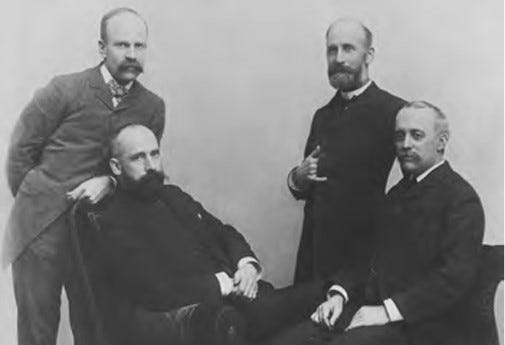
In 1908, West Publishing Company introduced an indexing system for all American law. In 1975, the company introduced Westlaw, a computerized legal research system. In 1996, the company was sold to Thomson Reuters for $3.4 billion.
Marion Waugh Brashears Gill (1870 - 1952)
Born in Illinois, Marion Waugh married James Bradley Brashears (1873 – 1944) in Chicago in 1894. When only child Marion’s father, Charles Johnston Waugh (1842 - 1923), who came to Los Angeles in 1905, died, Marion inherited his estate. In 1924, Witmer & Watson designed a house for Mrs. Marion Waugh Brashears, in Palos Verdes Estates (Palos Verdes Estates had been designed by Gill's friend, Frederick Law Olmsted). Gill was the landscape architect for Marion’s Palos Verdes home. Marion lost a large amount in the 1927 Julian Petroleum Corporation stock swindle. In 1928, Marion Waugh Brashears, a vocational analyst and “the niece of potent Publisher John C. Shaffer” married Gill. Gill found Palos Verdes too pretentious and moved to Marion’s avocado ranch in Carlsbad - where he died in 1936. Marion's grave is unmarked in an area of community graves for unclaimed / unpaid cremains.



